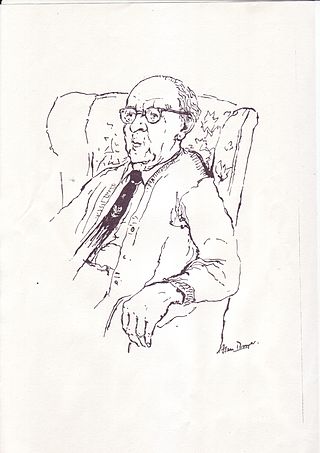
The Hawker Siddeley Harrier is a British jet-powered attack aircraft designed and produced by the British aerospace company Hawker Siddeley. It was the first operational ground attack and reconnaissance aircraft with vertical/short takeoff and landing (V/STOL) capabilities and the only truly successful V/STOL design of its era.
British Aerospace plc (BAe) was a British aircraft, munitions and defence-systems manufacturer that was formed in 1977. Its head office was at Warwick House in the Farnborough Aerospace Centre in Farnborough, Hampshire. It purchased Marconi Electronic Systems, the defence electronics and naval shipbuilding subsidiary of the General Electric Company, in 1999 to form BAE Systems.

The Harrier, informally referred to as the Harrier jump jet, is a family of jet-powered attack aircraft capable of vertical/short takeoff and landing operations (V/STOL). Named after a bird of prey, it was originally developed by British manufacturer Hawker Siddeley in the 1960s. The Harrier emerged as the only truly successful V/STOL design of the many attempted during that era. It was conceived to operate from improvised bases, such as car parks or forest clearings, without requiring large and vulnerable air bases. Later, the design was adapted for use from aircraft carriers.

Hawker Siddeley was a group of British manufacturing companies engaged in aircraft production. Hawker Siddeley combined the legacies of several British aircraft manufacturers, emerging through a series of mergers and acquisitions as one of only two such major British companies in the 1960s. In 1977, Hawker Siddeley became a founding component of the nationalised British Aerospace (BAe). Hawker Siddeley also operated in other industrial markets, such as locomotive building and diesel engine manufacture. The company was once a constituent of the FTSE 100 Index.

Sir Sydney Camm, CBE, FRAeS was an English aeronautical engineer who contributed to many Hawker aircraft designs, from the biplanes of the 1920s to jet fighters. One particularly notable aircraft he designed was the Hawker Hurricane fighter.

Number 4 Squadron, normally written as No. IV Squadron, is a squadron of the Royal Air Force. Since November 2011, it has operated the BAE Hawk T2 from RAF Valley, Anglesey, Wales. The squadron provides weapons and tactics training for student pilots after they have completed their conversion to jet aircraft with No. XXV(F) Squadron. Between 1970 and January 2011, No. IV Squadron operated various marks of the Hawker Siddeley Harrier and British Aerospace Harrier II.

Brough Aerodrome was a private use aerodrome located at Brough, East Riding of Yorkshire, England. It is now disused with the last known flight out of the airfield occurring in 2011. The airfield closed in 2013. The site is now crossed by a new road "Baffin Way" serving the town.

Alfred William Bedford OBE AFC FRAeS was a British test pilot and pioneered the development of V/STOL aircraft.
BAE Systems Military Air & Information is a business unit of British defence company BAE Systems responsible for the design, development, manufacture and support of fixed wing military aircraft. MAI customers include the Royal Air Force, Royal Saudi Air Force, US Navy and Indian Air Force.

Sir Arnold Alexander Hall was an English aeronautical engineer, scientist and industrialist.
Ralph Spenser Hooper, OBE, FREng, FRAeS was an English aeronautical engineer, recognised mostly for his work on the Hawker Siddeley Harrier, specifically in relation to the marriage between the Pegasus engine and the layout of the aircraft, allowing it to safely hover with margins of stability.
Stuart Duncan Davies CBE FREng FRAeS was a British aerospace engineer who was in charge of the design of the Avro Vulcan. He was also responsible for converting the unsuccessful two-engined Avro Manchester into the four-engined Avro Lancaster.
899 Naval Air Squadron was a squadron of the Fleet Air Arm of the United Kingdom.

Roland Henry Chaplin,, known as Roy Chaplin, was an aeronautical engineer who worked with Sydney Camm at Hawker Aircraft Limited from 1927 to 1962. He helped design the Hawker Fury biplane, the Hurricane monoplane, and the Harrier jump jet. He graduated with a degree in engineering from London University and retired in the 1960s.
Michael Henry Bruce Snelling is a former British fighter pilot, test pilot and airline pilot.
Richard Walter Walker FRAeS was a British aerospace engineer, and main designer for jet aircraft of Gloster Aircraft Company.
John Frederick Farley, was a British fighter pilot and test pilot for the Royal Air Force who was made an Officer of the Order of the British Empire for his work in aviation. As a test pilot, he was heavily involved in the development of the Hawker Siddeley P.1127 and latterly the BAE Harrier. During his aviation career Farley flew over 80 different types of aircraft and was the first British pilot to fly the Mikoyan MiG-29.









